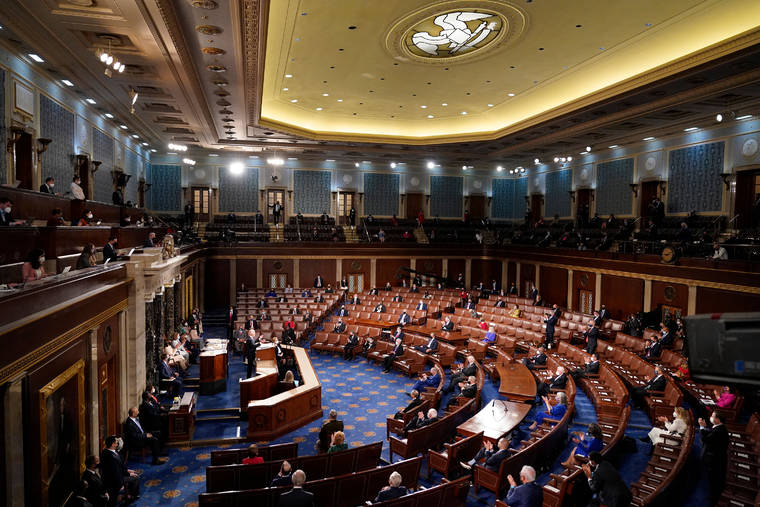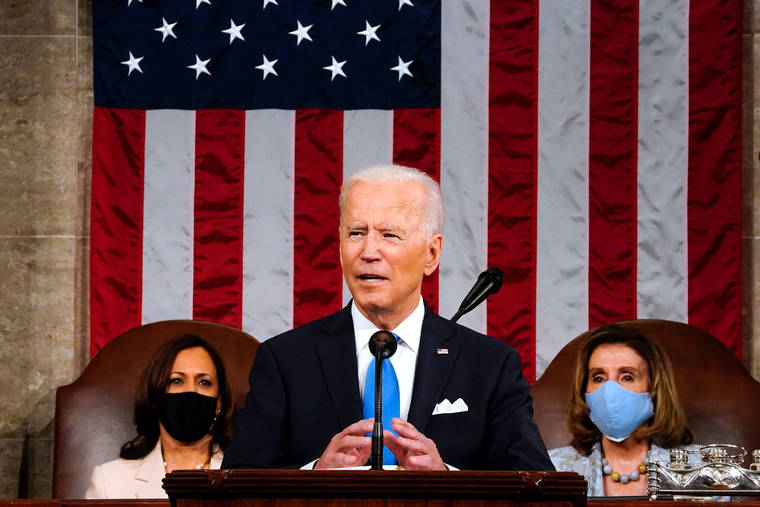WASHINGTON — President Joe Biden, who has already signed one of the costliest measures in U.S. history to help the country rebound from the coronavirus crisis, is pushing for even more aggressive, long-term actions to reshape American life in his first address to a joint session of Congress on Wednesday.
The nationally televised, prime-time speech represents a coda to Biden’s initial 100 days in office, during which he focused on expanding vaccine distribution to slow the infection and death toll from COVID-19, and a pivot toward an increasingly ambitious agenda that, if successful, would make his presidency among the most transformative in generations.
“Tonight, I come to talk about crisis and opportunity,” Biden said.
“America is on the move again,” he added. “Turning peril into possibility, crisis into opportunity, setback into strength.”
Pandemic restrictions left the president speaking to a relatively sparse gathering of fewer than half the 535 members of Congress in the House chamber, rather than to the usual packed audience of lawmakers, Supreme Court justices, Cabinet officials, military leaders, diplomats and other guests.
Biden began by acknowledging the historic moment represented by two women behind him on the House dais — “Madam Vice President” Kamala Harris and “Madam Speaker” Nancy Pelosi, D-Calif. He was the first president, he noted, to be greeting women in both seats reserved for the two people next in the line of succession to the presidency. “And it’s about time,” he said to applause.
Lawmakers were spaced three or four seats apart, including in the gallery normally reserved for guests. During most years, a handful of members stake out the seats along the center aisle hours in advance to appear on television shaking the president’s hand as he enters. This year, no one was allowed inside until two hours before and each had a seat assigned by the speaker’s office.
Metal fencing and National Guard troops ringed the Capitol, a reminder of the enhanced security that remains in place months after the Jan. 6 siege by supporters of then-President Donald Trump. Biden described the riot in his speech as “the worst attack on our democracy since the Civil War,” an event that continues to cast a shadow over the building.
Hours before arriving at the Capitol, in a meeting with network and cable news anchors, Biden said his first goals after his inauguration were “ease the pain, save lives, put people in a position where they have reason to believe that they could actually get back and earn a living and provide for their families.” Now he wants to win what he describes as a global philosophical debate — centered on U.S. competition with China — over whether democracies can deliver for their citizens as efficiently as the autocracies that are gaining ground worldwide.
“Because if we go four more years like we had in the last four, I really, honest to God, believe we’re in real jeopardy as a nation,” Biden said.
Biden is using the speech to outline what he calls the “American Families Plan,” a just-released $1.8 trillion, 10-year proposal that would increase taxes on the wealthy to expand educational opportunities, provide paid family leave and offer tax credits to reduce the cost of child care. Low- and middle-income families would be eligible for two years of preschool and two years of community college at no cost.
To pay for the proposals, Biden wants to end the favorable tax rate on capital gains from stocks and other assets for people earning at least $1 million per year and to undo Trump’s reduction in the top income tax rate for wealthy Americans, restoring it to 39.6% from 37%.
The sweeping initiative comes on the heels of what the administration calls the “American Jobs Plan,” an even more expensive array of proposals to repair roads and bridges, expand broadband internet access, replace lead pipes and invest in caregiving programs for the elderly. The total cost is more than $2.25 trillion over eight years, and it would be financed largely by increasing the corporate tax rate, partially reversing a cut made by Trump and a Republican-controlled Congress in 2017.
Biden, an affable and familiar personality who has proved to be an effective frontman for progressive policy, already signed into law a $1.9 trillion plan for COVID-19 relief, extending unemployment benefits, delivering $1,400 payments to most Americans and funding the nationwide inoculation campaign. Including the two longer-term packages, Biden’s plans would amount to about $6 trillion in spending and tax credits to invest in the nation’s human and capital resources.
In his speech, Biden is likely to combine a forward-looking explanation for such huge investments with a valedictory for the advances during his first months in office against both the pandemic and unemployment.
The U.S. has vaccinated a greater percentage of its population than almost any other country. Nearly 43% of Americans have received at least one dose, and 29% are considered fully vaccinated, according to the Centers for Disease Control and Prevention. On Tuesday, Biden touted “stunning progress” made since he took office, and public health officials announced that fully vaccinated Americans no longer need to wear masks during outdoor activities as long as they’re not in crowds.
Although no Republicans supported Biden’s coronavirus relief package, their party has failed to mount much opposition to the legislation or diminish its popularity with the public. According to a recent poll, roughly 7 in 10 Americans approve of Biden’s overall handling of the pandemic.
However, Biden’s latest ideas are already being hotly contested on Capitol Hill, where Republicans are blasting them as an extravagant liberal wish list and some Democrats are pushing for even more spending on social services.
Sen. John Thune, R-S.D., the Senate’s second-highest-ranking Republican, described Biden’s plan as originating from the “hard left.”
“This is a transformational strategy, and they see it as a once-in-a-lifetime opportunity, along the lines of a couple of times we’ve seen in the history of our country where Democrats get power and just want to really build government,” he said.
Meanwhile, House Democrats released their own array of proposals that go beyond Biden’s plan, such as making the enhanced child tax credit permanent. Biden’s proposal would extend the credit through 2025.
Enacting any of this legislation will probably require unanimous Democratic support because the party has slim majorities in the House and Senate.
While congressional Republicans offered a scaled-down infrastructure package last week — an indication there may be room for a bipartisan compromise to repair roads, bridges, rail lines and airports — it’s unlikely the White House will win bipartisan support for its sweeping investments in workers and families. That leaves Congress’ so-called reconciliation process, which allows the Senate to sidestep filibuster threats to pass budget-related proposals, as the Democrats’ best shot at making Biden’s latest plan a reality.
Times staff writer Sarah D. Wire contributed to this report.


